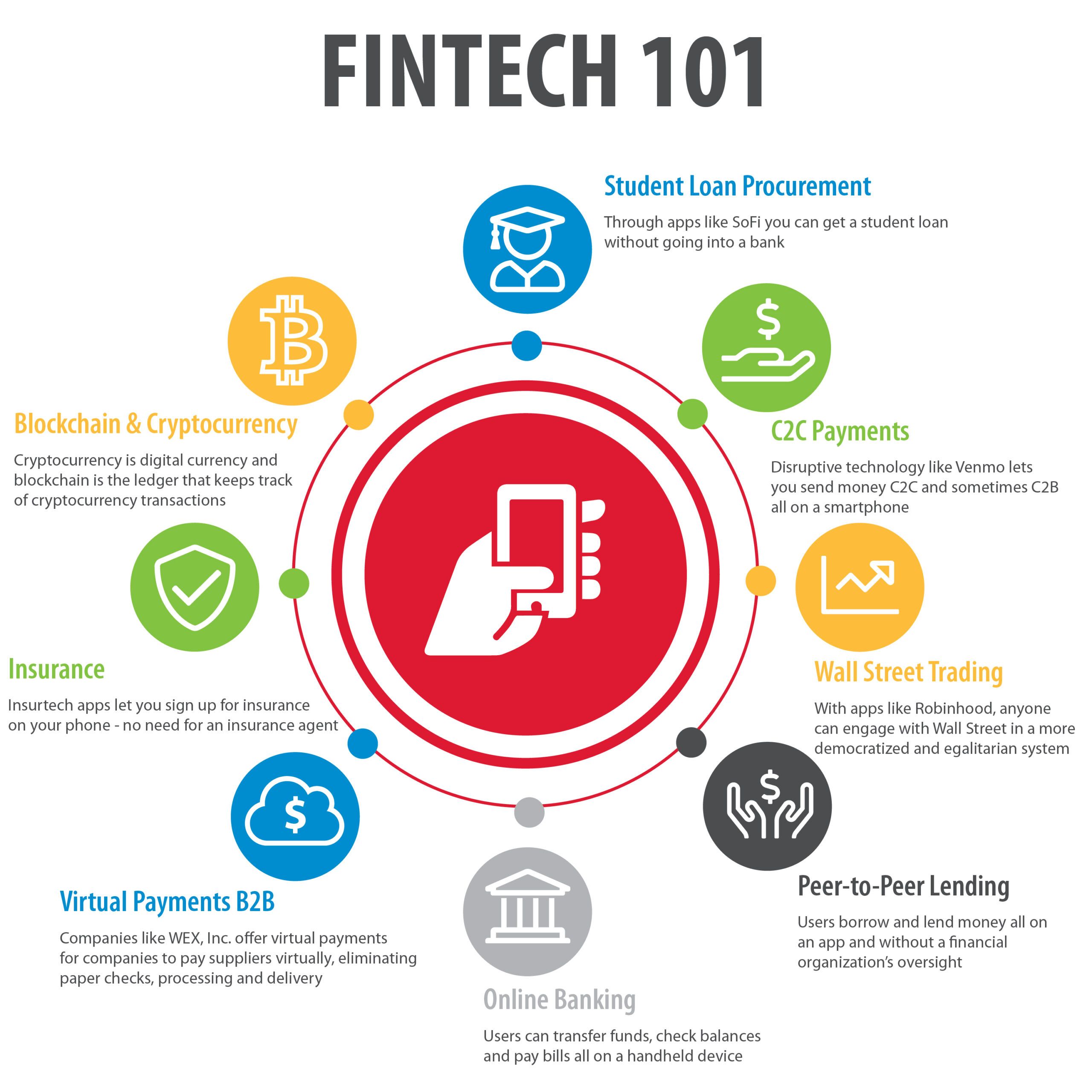Stay connected
Subscribe to our Inside WEX blog and follow us on social media for the insider view on everything WEX, from payments innovation to what it means to be a WEXer.

Have you heard the word “fintech” thrown about over the course of 2019? Did you wonder to yourself, “Just what is fintech, anyway?” You are certainly not alone. Fintech is intertwined with so much of how we live today. Once you understand what it is, you’ll realize that fintech is ubiquitous.
Did you check your bank balance on your phone on the way to work this morning? Will you Venmo a friend today for drinks shared last night? Have you recently booked a vacation on Expedia? Does your business make payments virtually? Have you ever felt like you’re living in a cashless society? If you answered yes to any of the above, you are living the fintech life. And many of us would say yes to all of the above. Look out, world, fintech has arrived and it’s not going away anytime soon.

Financial Technology, or fintech, has a broad reach. It’s described as any emerging technological innovation that competes with more traditional methods of delivering financial services. This disruptive and innovative technology changes and improves the way people engage with their finances. It was born out of a combination of the fallout from the 2008 global financial crisis and the launch of the smartphone. Fintech impacts personal banking as well as B2B financial products and services. It’s become pervasive in this era of human symbiosis with our interactive handheld devices. It’s now become an expectation that more and more of our needs be met on our personal devices. As none of us ever stray very far from our handhelds, connecting to anything important via smartphone is an ever-expanding phenomenon.
Users of fintech run the gamut from consumers checking a bank balance to small business owners applying for a loan, to Fortune 500 companies employing virtual cards. Fintech is all around us and changing how we participate in personal and business banking.
There are three primary ways fintech is employed in B2B transactions:
Examples of B2C fintech solutions for small business include:
Millennials are digital natives and as a result, are a natural fit for this emerging technology. As consumers, millennials have an expectation that money transfer—and really, any banking—should be mobile-friendly. They believe banking should be effortless and scalable and accomplished ideally without stepping foot inside a bank. Fintech focuses on millennials because they get it. They are also over 75 million strong and have a rising earning potential. They are on pace to overtake Baby Boomers in spending power within the next year.
Baby Boomers and Gen Xers generally don’t have their needs met by emerging technology in the same way that millennials do, though Gen Xers are growing more engaged with financial technology tools by the day. Gen Xers grew up in the very early days of digital technology, so it’s a conundrum why they have not adopted financial technologies in the way that millennials have. There is some speculation that because this generation experienced not just one but two recessions, it has an inherent distrust of financial institutions and, as a result, has shied away from the adoption of these technological developments. Gen Xers also have higher expenses and more debt than Baby Boomers and millennials, so less comfort in adopting new fintech tools as a result.
Cryptocurrency is a digital or virtual currency. It is nearly impossible to counterfeit or double-spend cryptocurrency. What makes cryptocurrency particularly appealing to the majority of its users is its independence from any government or other administrative oversight. Cryptocurrency puts control in the hands of the individual by removing the bank as the middleman. Bitcoin was the first cryptocurrency on the market and was launched in 2009. Bitcoin uses fintech to facilitate instant payments. This technology is peer-to-peer which means money can be sent between two people without anyone in the middle interfering. There are fees involved but they are far less onerous than what traditional financial institutions currently charge.
WEX’s Nicola Morris defines blockchain beautifully: “Blockchain is a ledger. Something to track the exchange of value to record transactions. It’s a new version of the old paper ledger that was computerized in the 80s and the 90s. But this ledger is special. It resides in multiple places with exactly the same information that is continuously updated. Everybody has access to the same exact information… You record a transaction by doing a math problem and laying it down in the block. That’s what forms the chain.” Blockchain is tamper-proof and a great tool for underlying cryptocurrencies like Bitcoin, as it keeps a record of all transactions. It’s basically a way to organize information about transactional data.
Using APIs (application programming interfaces), open banking gives third-party organizations complete access to financial data and transactions between consumers and B2B organizations with their respective financial institutions and B2B transactions with financial institutions as well. Open banking allows a company like Venmo to access financial data that had previously been proprietary and inaccessible.
Insurtech is fintech for the world of insurance. In 2010, innovators saw an opening in the insurance industry for disruption and found insurance ripe for innovation. Using technological innovation, start-ups in the insurance industry have helped develop efficiencies and ways to provide more cost-effective products and services. With the advent of insurtech apps, consumers are able to engage with insurance customized to the particular details of their lives all on a smartphone without any human interaction. Like fintech, insurtech is democratizing the insurance industry.
The unbanked are people who have no affiliation with any financial institution. They typically pay for things in cash or money orders and while the majority of the unbanked are in developing countries, there are pockets of unbanked in developed countries like the United States.
Some are unbanked due to a financial situation out of there control whereas others choose to be unbanked because of a lack of trust in financial institutions. An ideal target market for much of the fintech innovation that’s transpired over the last decade is the unbanked. Fintech simplifies a lot of banking processes and procedures which may make it easier for the unbanked to participate. Because financial institutions are removed from the equation, the purposefully unbanked might also be more inclined to participate.
mPesa, a Kenyan company, is using fintech to engage the unbanked. mPesa provides a tool for constituents to store and transfer their money simply by using an app on their phone. Individuals who are currently unbanked find it easy to use their products. As a result, those who have engaged with mPesa have more control over their finances, and a host of opportunities emerges for the unbanked once they can engage with money digitally.
With financial transactions now occurring consistently on computers and mobile devices, it seems possible to foresee the future obsolescence of brick and mortar financial institutions. Being able to engage in personal banking, borrowing money and even trading on a laptop, tablet, or smartphone removes the middleman banking professional.
The way we’ve always experienced financial services is through pre-packaged bundles of products. In the traditional model, when we walk into a bank and sit down with a banking professional, we are provided a package of services including trading, mortgage lending, and traditional banking. Fintech unbundles this package for users, giving each individual the option to pick and choose which services they want and do so at their own pace and at their own level of ability.
By unbundling products and services, fintech serves a wider range of users. Not only is the process simplified, but users who in the past would have been excluded for a variety of demographic reasons are now invited into the fold. Companies like Nutmeg come out and say it right on their homepage: “We’re on a mission to democratize wealth management.” Barriers to participating in financial services typically arise in the traditional, brick and mortar model.
Studies suggest segments of society find banks intimidating and/or inaccessible. With fintech, these types of barriers disappear. Anyone can purchase stocks. Far fewer people feel inadequate or not sophisticated enough to make use of financial tools. The technology allows anyone to jump on a laptop and engage, resulting in far greater access.
This unbundling of financial services has allowed fintech startups to streamline their offerings. Streamlining combined with emerging technology creates efficiencies mostly by removing layers of people and paperwork from the process. This results in better price points for consumers. It also results in a more egalitarian system.
Disruptive fintech products are becoming omnipresent and, ironically, pedestrian. It is increasingly unlikely for the average person to get through a day without touching something fintech-related. Here are some examples of disruptive fintech products in the current marketplace:
Venmo is a money exchange app developed in 2009 by recently-graduated college roommates from the University of Pennsylvania. Ven(to sell)mo(mobile) allows people to transfer money to family, friends, and vendors via a smartphone app. Users join the app and enter banking information and then become part of the social media world of Venmo where friends and family are there exchanging cash (with the added benefit of emojis!) in real-time. Venmo handled over $12 billion worth of money exchanges in Q1 2018 alone and in the third quarter of 2019 had a net payment volume of 27 billion U.S. dollars, which illustrates a 64 percent year-on-year growth.
Robinhood is a mobile-only stock trading app that allows users to make investments without paying any commission. In a traditional stock market trading situation, stockbrokers, who are experts on the market, give investors financial advice for which they are paid a commission. Robinhood, rather, charges no fees for trades. There is no stockbroker to pay, just free technology in his/her place. Robinhood has become a popular tool amongst millennials, with no account minimums to hinder young people from participating. With more than six million users, a $7.6 billion valuation, and an IPO in the works, Robinhood is said to have disrupted the brokerage industry. Another example of a fintech showing democracy in action.
Peer-to-peer lending institutions such as Prosper Marketplace, Lending Club and OnDeck are fintech organizations that allow individuals to engage in loaning and/or borrowing money without involving a third-party financial institution.
SoFi is primarily a loan repayment financial technology for student loans. They also offer mortgages and personal loans which can be procured without entering a brick and mortar financial institution. The founders’ vision was to provide more affordable student loan repayment options by cutting out costs associated with a brick and mortar shop.
As WEX’s Nicola Morris aptly articulates it, blockchain is “the technology that’s going to democratize and revolutionize commerce—freeing up hundreds of billions of dollars in cost and making it easier for all of us to trust and transact.” This description of blockchain encapsulates the overarching concept of fintech as well. Fintech is democratizing commerce and placing financial control into the hands of consumers while freeing them from the bonds of the brick and mortar financial institution.
Join the fintech revolution! Contact us to learn more about how WEX can provide fintech solutions to your business.
Resources: Pymnts.com, TheStreet, Yapstone, Investopedia, TheHustle, U.S. News & World Report, FusionFabric, Paysafe, Blockgeeks
Subscribe to our Inside WEX blog and follow us on social media for the insider view on everything WEX, from payments innovation to what it means to be a WEXer.